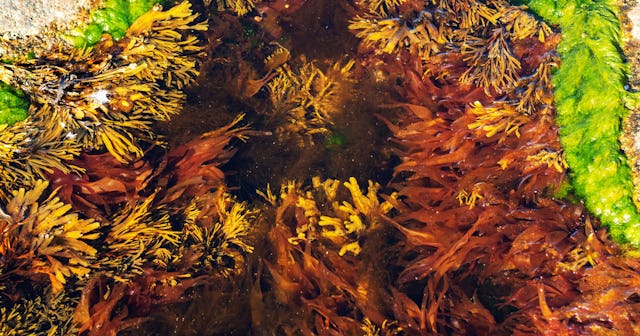Sea Moss Gel Is In The Spotlight—What Is It, And What Does It Do?

Another day, another TikTok wellness trend to keep up with. TikTok influencers seem to love wellness trends that promise clear skin and toxin free bodies and the sea moss trend is no different. TikTok influencers are touting the benefits of sea moss—a type of red algae—to their followers, lauding its purported ability to clear skin, eliminate toxins from the body, and help you breathe better.
Naomi Maldonado raved to her 44,000 followers about the health benefits, claiming that once they start taking sea moss, they might start coughing up phlegm, which is a good sign. She said, “It’s a good thing because you’re clearing out all that stuff that doesn’t belong in your lungs and you’re gonna be able to breathe so much better.”
Sea moss even made the Pinterest 100, an annual rundown of the top trends to “inspire and try.” Sea moss grew in popularity by a whopping 380 percent and the Pinterest team noted that “sea moss is the latest ingredient to try in your next smoothie or juice recipe.”
As is often the case with a TikTok trend, there’s more to the story than what can be captured in a post.
Sea Moss Was Used Long Before TikTok Existed
ablokhin/Getty
Sea moss may be having its TikTok moment, but it’s actually been around for hundreds of years. Maybe longer. According to the International Food Additives Council, humans have been harvesting Irish Moss for about 14,000 years.
“Irish sea moss has been used for generations in places like Ireland, Scotland, and Jamaica in food and as folk medicine,” Robin Foroutan, R.D.N., spokesperson for the Academy of Nutrition and Dietetics told Shape Magazine.
During the Irish Potato Famine in the 1800s, sea moss was used as a source of nutrition. Not surprising. It contains high amounts of calcium, magnesium, iron, vitamin K, folate, and iodine. People also believed that it helped with colds, flu, and congestion.
Sea Moss As A Functional Food
In an interview with Byrdie.com, Lisa Borg, nutritionist at pulselightclinic.co.uk, highlighted the benefits of sea moss. She said, “Irish moss supplies many nutrients that are often missing from the average diet, such as vitamin A and omega-3 fatty acids, which are both essential to healthy skin and inflammation control.”
Sea moss, like other sea vegetables, is considered a “functional food,” which means that it offers health benefits beyond the usual vitamins and minerals. The blend of fiber, protein, and high nutrient density makes it a good addition to most diets.
While sea moss itself has not been extensively studied, the few studies that have looked at it have found a variety of benefits, including digestive benefits related to gut health. Likewise, there is evidence that sea moss supports immune health, helps fight some cancers, protects against neurodegenerative diseases, and supports muscle and energy recovery.
How To Consume Sea Moss
nazimpressions/Getty
Sea moss is often eaten as a gel, which is made by boiling raw or dried sea moss. Some cultures serve it as a drink mixed with milk and sweetened with sugar or honey.
Some folks add sea moss to smoothies or dissolve it in water. According to Foroutan, when ingested like that it can help calm the respiratory and digestive tract. When added to water, it can act like a soluble fiber to keep things moving.
Skincare brands are also turning to sea moss for its topical application benefits. It contains antimicrobial and anti-inflammatory properties, which helps with aging and acne, Joshua Zeichner, M.D., director of cosmetic and clinical research in the department of dermatology at Mount Sinai Hospital in New York City, told Shape.
Use Good Quality Sea Moss In Moderation
So often too much of a good thing becomes not actually a good thing. Sea moss is no different.
Sea moss contains iodine, which, in small amounts, can be good for thyroid health. In excess, it can lead to thyroid dysfunction, and even possibly to thyroid cancer. The FDA recommends about 150 mcg of iodine per day. The actual amount in a serving of sea moss can vary based on where it’s sourced from so it’s important to check the labels.
It’s particularly important for anyone with thyroid issues to check with a doctor before adding sea moss to their diet, Dietitian Sophie Medlin told Byrdie.
Likewise, too much sea moss can expose you to heavy metals, including arsenic and mercury.
“Seaweeds accumulate toxic heavy metals such as cadmium, mercury, lead and arsenic,” Borg said, and “[t]he shorelines where Irish moss grows are not certified clean of these toxic metals, or petrol products, or pesticides and herbicides for that matter.” As a result, she would suggest using only certified organic Irish moss, if you plan to incorporate sea moss into your diet, at all.
If you decide to consume sea moss in pill or powder form, keep in mind that the supplement industry is not regulated. For that reason, look for a supplement that’s been independently tested for impurities by a third party.
Clearly sea moss has a lot of benefits. Claims of influencers notwithstanding, it’s also withstood the test of time. However, before you run out for your own serving of sea moss, keep in mind that it has not been extensively studied, nor have there been many studies looking at the long-term benefits. As a result, it’s best to check in with a doctor or dietician to determine if sea moss is right for you.
This article was originally published on